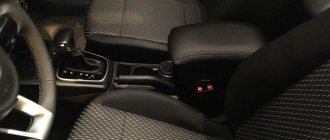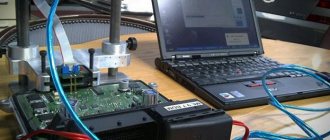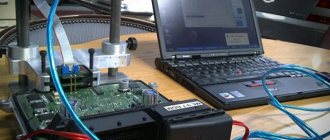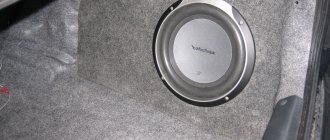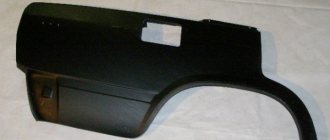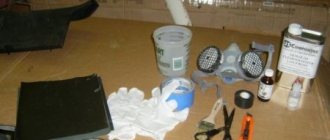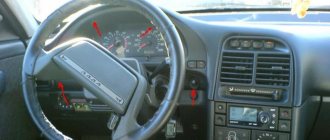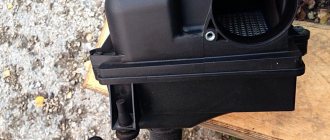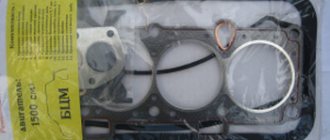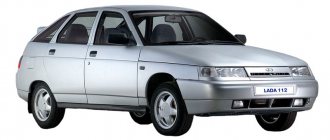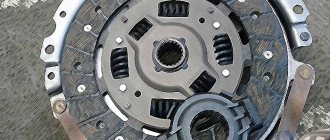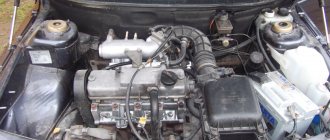Articles
- 2 Let's start with the hood
2.1 Let's move on to the motor shield
- 5.1 First layer
Sound insulation of the trunk of a VAZ 2112 is carried out together with the bottom
Applying soundproofing to your car is not so much an achievement of comfort as it is an urgent necessity. In all interiors of domestic cars there is no sound insulation, and even if there is some, it still lets in extraneous sounds. Therefore, you have to eliminate such a deficiency with your own hands.
What is it for?
Soundproofing today is needed not only by lovers of good music:
- Extraneous noise in the cabin interferes with normal conversation
- In addition, noise has an irritating effect on the driver, reduces his reaction and thereby poses a threat to his life.
- Spending a long time in a cabin with constant noise disrupts nervous activity, increases a person’s irritability, and impairs sleep.
- Finally, loud noise constricts the blood vessels in the body, which increases the load on the heart and can cause angina over time.
- You can’t buy health, so you need to take care right away
- Soundproofing the VAZ 2112 itself will solve all problems
- So that you don’t have to worry about time and money, it is recommended to do it in stages, starting with light areas that do not require disassembling the interior
Quantity and types of materials
The components used in sound insulation differ in characteristics, methods of their fastening and price:
- The assortment today is wide, both in online stores and in auto parts stores.
- Of these, Isoton and Accent are considered the most effective in sound absorption
- For vibration absorption - Bimast and Vibroplast
- Anti-squeak – Bitoplast and Madeline
- On the bottom – 13 sheets of vibration damper + 13 sheets of sound insulator, dimensions 0.5 * 0.75 meters
- On the roof - 4 sheets of vibration insulation + 4 sheets of sound insulation, dimensions 0.5 * 0.75 meters
- VAZ 2112 trunk sound insulation – 10 sheets 0.3 m 2 – vibration + 0.8 m 2 sound insulation
- On the door - 5 sheets of vibration insulation 0.5 * 0.75 meters + 0.8 m 2 sound insulation
- Madeleine is applied in places, so 1 sheet is enough
- Manufacturers, depending on the materials used, recommend treating surfaces in the following percentages:
- 60% vibroplast and 40% bimast or vice versa
- However, many owners apply 100% of one material to all surfaces
Let's start with the hood
The hood cover and the engine compartment partition are the simplest areas where you can start and practice at the same time:
Vibration insulation is glued exclusively between the stiffeners
- It reduces the noise level from the engine into the cabin, plus it provides thermal insulation, which the engine needs in winter
- To achieve a noticeable effect, it must be carried out in conjunction with the treatment of the engine shield.
- Competent sound insulation is carried out in three layers
- The first layer is always a vibration damper, as the instructions say
- The vibration damper must certainly have a foil layer to better reflect heat waves, because the temperature under the hood when the engine is running reaches a fairly high level
- You apply the material on flat surfaces between the stiffening ribs, as in the photo above
- The second layer is made of foil insulating material, for example, Splen
- This second layer plays the role of thermal insulation and sound insulation; it covers the entire area, including stiffeners
- The third layer is usually standard (factory, standard) sound insulation
- We process the trunk lid in a similar way.
Let's move on to the engine shield
To make high-quality sound insulation of the engine panel in the cabin, you need to remove the dashboard:
- Therefore, together with the hood, the outer side is processed, which does not require disassembly
- Everything is the same, two layers of the same materials, and in the same sequence
- And the procedure in the cabin is combined with soundproofing the dashboard
- The first layer will also be a vibration-insulating material, Vibroplast or Bimast is ideal
- A vibration damper should also be applied to all side surfaces, as well as technological holes, only a thinner one
- The second layer involves gluing with noise-insulating material, here the entire surface is also covered with Accent (inside the cabin, Accent is more advantageous than Splen)
- The thickness of the sound insulator is ten, or preferably fifteen centimeters
- Experts recommend sealing the contact points between the dashboard and the panel body with 10 mm bitoplast to reduce squeaking, and in places where it does not fit, using a thinner anti-creaking material - Madeleine
- Install factory sound insulation as the next layer, if there is any.
- If standard sound insulation is unsuitable for further use, you can purchase a new one
Sound insulation of engine shield
To carry out high-quality sound insulation of the engine panel, it is necessary to remove the dashboard. For this reason, it is logical to combine the procedure with soundproofing the dashboard.
The first layer is applied vibration-proofing material. A vibration damper is ideal. A vibration damper is also applied to the side surfaces and technological holes, but in a thinner layer.
The second layer involves gluing with soundproofing material. The entire surface is covered with “Accent” with a thickness of 10 or 15 mm. Experts recommend sealing the contact points between the instrument panel and the body with 10 mm bitoplast to reduce squeaking.
After soundproofing, a third layer is laid - soundproofing. The front wheel arches are covered with 4 or 8 mm soundproofing material "Spleen".
The fourth layer is the installation of factory sound insulation. If the standard sound insulation continues to be unsuitable, purchase a new one and install it.
External sound insulation of the VAZ 2112 engine shield.
Treating the roof
The work of soundproofing a roof is the simplest and at the same time the least expensive:
- Here, for high-quality sound insulation of the roof, it is enough to install only two layers
- As always, the first layer is vibration insulation; you cover the entire flat surface of the roof with it.
- Vizomat is recommended as a vibration-insulating material, two millimeters thick
- The second layer is a noise-insulating layer from Accent
- Bitoplast, with a thickness of 5 millimeters, or 10 millimeters, is applied to the ribs of cruelty, the entire flat surface is Accent, with a thickness of 10 millimeters. In the space under the handles and shades, it is sealed with Bitoplast 4 millimeters
Roof treated with vibration insulation
Quantity and types of materials for soundproofing the interior of the VAZ 2110.
Components for sound insulation differ in their characteristics, fastening methods and price categories. The assortment is widely represented both in online stores and in car showrooms. The most effective sound absorption materials are isotone and biplast. Isotone sound absorption coefficient: 0.4–0.94 arb. units, and biplast: 85%.
Approximate amount of material required for sound insulation:
- For the floor - 13 sheets of vibration material + 13 sheets of sound insulation, measuring 0.5 m * 0.75.
- For the roof - 4 sheets + 4 sheets of sound insulation, size 0.5 m * 0.75.
- For the trunk of a VAZ 2111/2112 – 10 sheets (0.3m2) + 0.8m2 of sound insulation.
- For doors - 5 sheets of vibration insulation (0.5 m * 0.75) + 0.8 m 2 sound insulation.
Manufacturers, depending on the materials used, recommend sheathing surfaces with a percentage ratio: 60% vibroplast to 40% bimast or vice versa. But many, when doing their own soundproofing, apply 100% of the material to the plane.
Soundproofing the bottom
When the VAZ 2112 is soundproofed, you will have to disassemble the interior yourself, remove all the rugs and seats:
- In addition, remove the standard Shumka, if present
- Only after complete disassembly of the interior, the laying of vibration insulation with Vizomat, Vibroplast, or Bimast Bomb (the price of which you like better) begins; you process the entire flat surface of the tunnel, and the bottom
- When installing vibration-absorbing material, it is important to stick it tightly and roll it tightly to remove bubbles
Soundproofing the bottom of the cabin
- An Accent or Isoton sound absorber is laid on top of it
- The thickness of the soundproofing material for the bottom is required at least 10 millimeters
- A 10 mm layer of Bitoplast is recommended for noise insulation of a tunnel.
- An 8-mm-thick accent is applied to the trunk, including the niche for the spare wheel.
- Install standard sound insulation as the third layer
- It is recommended to treat the outside of the bottom with “liquid” Shumka, and it is also used to treat the outside of the wheel arches
- It is easy to apply and convenient for treating difficult areas, plus it is durable and protects against corrosion.
- It is much lighter than sheet insulation, which is important
- Can be applied faster using a sprayer
Soundproofing of floors
After disassembling the interior, vibration isolation is installed. Bimast Bomb or Visomat is used to treat the flat surface of the floor and tunnel. When installing vibration-absorbing material on the floor, it is important to seal the vibration dampers.
Noise insulation from the floor of a VAZ 2112 car.
The second layer is sound insulation. For the floor you can use Accenta or Isoton. The thickness of soundproofing materials for the floor must be at least 10 mm. To soundproof the tunnel, 10 mm Bitoplast is used. Splen 8 mm thick is used to soundproof the trunk - the spare wheel niche is treated.
The third layer is the installation of standard sound insulation.
Soundproofing the interior of a VAZ 2110,2112,2111 with your own hands is a broad question. The article describes how to soundproof the floor, doors, ceiling and trunk. The process itself takes no more than three weeks (if you work independently). To get started, you need to purchase materials and prepare tools.
ATTENTION! Now you can buy a completely new Pioneer MVH X580BT processor radio for only 2990 rubles! Don't believe me? Then follow the link and see for yourself! Read more"
Components for soundproofing the interior of the VAZ 2110:
- solvent – degreasing liquid: White Spirit;
- sound-proofing materials: vibration-, sound-absorbing; heat-, sound-proof and anti-squeak;
- in the absence of vibration-absorbing material, mastic (liquid metal or vibroplast) is applied using a spatula;
- bolts and screws of longer sizes (after sound insulation the surface rises);
- clips for attaching the ceiling area (the old ones are unusable after removal);
- industrial hair dryer (heats the material and attaches it to the metal in this way);
Door noise
First, the door trim is removed (this operation is the same for all doors):
- Then soundproofing materials are installed, first the surfaces are treated with a degreaser (alcohol or acetone)
- An exception will be the lower part of the door, where an anti-corrosion coating is applied.
- Sound insulation will also be made of several layers
First layer
The vibration isolator is glued to the inner surface of the outer side (panel) of the car door:
- For convenience, it is better to cut it into pieces in advance.
- The material is inserted through technological holes in the inner lining, having previously been heated with a hairdryer for better fastening.
- Lay it overlapping
- The more area you cover, the better.
- To eliminate air bubbles, roll out the material with a hard roller or the handle of a screwdriver.
Doors treated with the first layer - vibration insulation
- Then, soundproofing material (preferably Accent) is applied on top of the vibration insulation, however, it is advisable to cover the maximum area
- Then all technological openings on the inside of the door are completely covered with vibration insulation (at least with foil)
- Use Madeline to “hide” the contact points (as well as wires, speaker mounting areas and where the trim fits to the door)
- Some car enthusiasts additionally install Bitoplast on the inside of the trim
- After soundproofing the door, the trim is installed in the reverse order
- We recommend not using the car for about two days after this, you need to let the Shumka stick well
Sheathing glued with bitoplast
Tips for improving the process:
- All wires must be signed or marked during disassembly with multi-colored tape or a marker
- Self-tapping screws should also be marked and arranged by size and order of removal.
- When gluing materials, avoid gaps; it is much better to overlap
- Do not use a hairdryer at home to heat materials.
- Start laying the material in solid pieces, and then cut small pieces as needed
- Heat the vibromaterials until their black surface becomes sticky
- When processing the trunk, use thinner sheets
- Leave holes for fasteners free
- Don't forget to degrease all surfaces
- Additionally, check out our video material
Soundproofing VAZ 2110, 2111, 2112 – process of applying materials.
Before starting work, you need to dismantle all the elements of the interior: the dashboard, trim, handles, lights, etc. The application of sound insulation layers occurs in three or two stages - vibration material, sound insulation and factory (or vibration insulation). After separating the casing, the factory sound insulation of the VAZ 2110, 2111, 2112 and the vibration-absorbing component will be visible.
Application order:
1. Remove the factory soundproofing and clean off any dirt/rust.
2. Factory mastic (vibration-absorbing material) is not removed - a solvent (White Spirit) is applied to this surface. The surface is completely degreased using a sponge. There is no need to dilute the solution.
3. Allow time to dry the car (no more than 8 hours). The vibration material is not attached to a wet surface.
4. Anti-squeak materials are applied to the surface of the dashboard shield. The components are heated, placed on the surface and leveled with a metal roller to eliminate bubbles. To improve the effect, the wires are wrapped in madeleine.
5. Vibration-absorbing material is placed in the trunk, on the floor, ceiling and interior doors - cut with scissors in accordance with the required dimensions. After this, carefully remove the film and place the preheated part on the surface using an industrial hair dryer. Level with a metal roller to eliminate bubbles. The most difficult to reach places are the bottom of the dashboard and the door. For ease of application, it is better to cut the material into very small pieces.
The resulting trunk result:
Doors:
6. Soundproofing material is applied to vibration-absorbing or anti-creaking material. During the work process, a roller is used. The surfaces of the components are self-adhesive.
Floor:
Doors:
7. We apply factory sound insulation or one purchased by you if the factory one is in poor condition.
8. The trunk trim for VAZ 2111,2112 is glued with madeline.
9. Lay the casing and install the door trims.
10. Install the dashboard and other elements in the reverse order.
To improve the process:
- It is better to label all wires or mark them with multi-colored tape. Also mark the screws and arrange them according to size.
- When applying, avoid gaps - it is better to overlap.
- Do not use a household hair dryer to heat materials.
- It is recommended to start laying the material with solid pieces, then cut off small ones.
- The vibration material is heated until the black side becomes sticky.
- To soundproof the trunk, thinner materials are used.
One of the best radios in its segment. It is a diskless receiver that rationally uses the manufacturer’s developments in the field of digital audio processing. This is a full-fledged processor device, designed taking into account the needs of modern car enthusiasts. More details at the link.
- Matrix LCD display with wide viewing angle;
- Working with a USB drive;
- Built-in microphone, Bluetooth and wireless voice communication system (can connect up to 2 phones);
- Compatible with Android, iPod/iPhone;
- Maximum output power: MOSFET 50W x 4.
